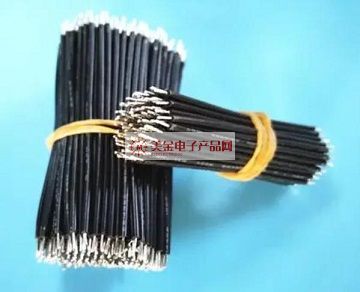Categorization:Product Information
Tin-impregnation of electronic wires is a common treatment used in the electronics manufacturing process, which involves immersing the exposed portion of a metal wire or cable in molten tin to form a protective tin layer. This treatment can provide a variety of benefits such as increased electrical conductivity, improved corrosion resistance, reduced oxidation, and ease of soldering. Electronic wire is a conductive wire used in electronic devices and circuits and is widely used in the manufacture and assembly of electronic products. Electronic wires are characterized by their small diameter, flexibility and ease of bending, good electrical conductivity, and are usually made of metals or alloys such as copper, silver, or tinned copper wire. Electronic wires usually have an insulating outer layer to prevent short circuits and other damage between the wires. Requirements for tinning of electronic wires can be determined based on specific applications and standards. The following are some common requirements: Tin Layer Thickness: The thickness of the tin layer is a critical parameter in tinning of electronic wires. The choice of thickness depends on the wire diameter, material and application requirements. Typically, a tin layer thickness of a few microns to tens of microns provides good protection and reliable solder joints. Uniformity: The tin layer should be evenly distributed over the entire wire surface to ensure consistent performance. There should be no visible bare areas or excessive tin buildup, which can lead to conductivity problems or poor soldering. Adhesion: The tin layer should be firmly attached to the wire surface and should not flake or peel off easily. Good adhesion ensures long-term stability and reliability. Finish: The surface of the wire after tinning should be smooth and clean, free of impurities, contaminants or oxidized layers. This helps maintain the conductivity and reliability of the wire. Solderability: The tin-impregnated finish should make the wire easy to solder. The presence of a tin layer provides better solder contact and a reliable connection, thus reducing problems during the soldering process. Corrosion Resistance: The tin layer should have good corrosion resistance to prevent the wire from being damaged by oxidation, chemicals or environmental conditions during use.

-About US dollars electronic products network platform related to the introduction and sales of products brief: US dollars electronic products network - a professional agent / production / sales of a variety of {connectors | wiring harness | wire and cable products }; if you have a related [connectors | wiring harness | wire and cable products] purchasing / sourcing needs or would like to buy / to understand which connectors | wiring harness | wire and cable products we can provide solutions, please contact the following Division I business personnel; If you have a related [connectors | wiring harness | wire and cable products] sales / resources and promotion needs, please click "→ Business Cooperation ←" to discuss with a person! If you have related [connectors | wire harness | wire and cable products] sales / resources and promotion needs, please click on the "¡¡ Business Cooperation ←" to discuss with a person!